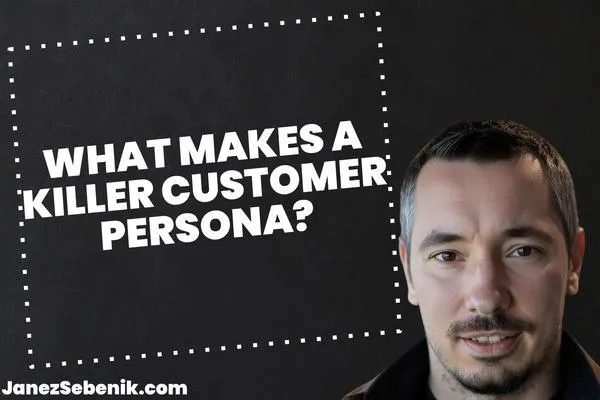
What Should a Customer Persona Look Like?
Knowing your customer is like having the secret sauce for your business. You want to understand who they are, what they want, and how they feel. A customer persona is a fictional character that represents your ideal customer, capturing their traits and behaviors.
Imagine you're creating a real-life profile of your best customer. You'd include basics like age and interests. But you'd also dig into their problems, needs, and buying habits.
This persona becomes your roadmap for developing focused marketing strategies and driving growth.
Don't skip this step if you're serious about making your business click with your audience. Crafting a well-thought-out customer persona is your way to align your strategies and boost product development. It helps you address constraints and even consider those you shouldn't be targeting.
Key Takeaways
Customer personas guide your marketing strategy by modeling ideal customers.
Understand the world of your customers to tailor your strategies for growth.
Use personas to refine product development and address diverse customer needs.
The Anatomy of an Effective Customer Persona
A killer customer persona helps you understand who you're selling to. Nail down the basics like demographics, then dive into deeper stuff like their values and interests. This mix makes your marketing game strong.
Getting Down to Basics: Demographics
Start with the bare bones: demographics. This is the foundation of your customer persona. You’re talking age, gender, and income. Think of these as stats on a sports card.
Don’t skip the essentials like location and occupation. These details help you figure out the best way to reach your customer. When you know where they hang out, you know where to place your ads.
List out these details clearly. It’s like setting up a game plan. You need to know who you’re playing with. An effective persona means understanding who they are at the simplest level. It’s straightforward, but don’t underestimate its power.
Diving Deeper: Psychographics and Behaviors
Let’s move from surface level to heart level. Psychographics dive into what makes your customer tick. This is where you dig into values and interests. What do they care about?
Understand their personality traits. This tells you how to talk to them. Do they appreciate humor or do they value seriousness?
Get into behaviors. What are their buying habits? Know this, and you’ll know how to make them click “buy.”
Identifying these psychographics and behaviors isn’t just guesswork. It’s smart, data-driven stuff. This info transforms a flat set of stats into a relatable character. It's the heartbeat of your persona.
Use this to make your marketing personal. That’s how you connect with your audience on a deeper level.
Understanding the Customer's World
Before diving deep, know this: your customer is the hero of your story. Their world revolves around their needs, challenges, motivations, and experiences. You must step into their shoes to truly understand them. This way, you can create exactly what they want.
Identifying Pain Points and Challenges
First things first, what keeps your customer up at night? Think about their pain points. Maybe they're struggling with lack of time, tight budgets, or poor-quality service. This is where empathy mapping comes in. It helps you step into their shoes and see things from their perspective.
Ask yourself:
What problems are they facing right now?
What annoys them about current solutions?
What do they wish could be better?
By nailing down their challenges, you can create solutions they’ll love. This makes them feel like you’re the answer to their problems. That’s how you win their hearts.
Goals and Motivations
Now, let’s talk about what pushes them forward. Your customers have goals and motivations that drive their decisions. Whether it’s a promotion, better health, or more free time, they’ve got dreams. You need to align with these.
Here’s how you can tap into this:
Know their personal and professional goals.
Understand what success looks like for them.
Figure out what motivates them to take action.
What you offer should be the bridge to their aspirations. Make sure it aligns with their desires. Treat their goals like your own, and you’ll make a real connection.
Mapping the Customer Journey
Finally, get familiar with their journey. From discovery to decision, your customer goes through several stages. They have expectations every step of the way. Your mission? Deliver an outstanding user experience.
Consider their path:
How do they first learn about you?
What information do they seek?
What makes them decide to buy or not buy?
This map is your secret weapon. Use it to smooth out any bumps and exceed their expectations. When you know the journey, you can create an unforgettable customer experience that keeps them coming back for more.
Crafting Your Persona: Tools and Techniques
You need the right tools and techniques to create customer personas that make sense. This involves smart research methods, understanding data through tools like Google Analytics, and using a clear persona template to guide you.
Persona Research Methods
Start by diving into market research and audience research. Use methods like surveys and interviews to grab customer insights straight from the source. Got existing customers? Use their feedback to build a rich profile.
Don’t forget quantitative data. Numbers don’t lie. Collect and analyze this data to spot patterns. That helps you understand who your audience personas really are. A mix of strategies is your best bet. Blend these methods to paint a complete picture of your ideal customer profile.
Utilizing Data: Google Analytics and Social Listening
Google Analytics is your friend here. It’s all about numbers. Track how users interact with your site. This tells you a ton about your audience personas. Clicks, time spent, pages visited — every action is a clue to their likes and dislikes.
Social listening is another goldmine. Keep your ears open to what’s being said about your brand on social media. Feedback from those platforms gives you real-time customer insights. Don’t just listen; analyze what you hear. Use this intel to adjust your persona’s needs and desires.
The Persona Template
Your persona template is the backbone of your strategy. Use it to document everything—from demographics and psychographics to goals and challenges. This template keeps your persona organized and easy to understand.
Be specific. Give your persona a name and a backstory to make them relatable for your team. This isn’t just a formality—it’s how you bring your persona to life. A clear persona template makes it easier for everyone to align on who your ideal customer is.
Persona-Driven Strategies for Growth
Using customer personas can transform your business approach. They help in crafting personalized marketing efforts, improving conversion rates, and tracking your return on investment (ROI).
Tailoring Marketing Campaigns
You want campaigns that speak your customers' language. Dive into the details of your customer personas. Understand their likes, dislikes, and what makes them tick. Use this insight to create messages that grab their attention.
Customized content marketing is key. Create content that resonates with your audience. Personalize marketing materials to ensure your product or service feels like it was made just for them.
Leverage influencer marketing. Choose influencers that match your persona. Their endorsement can create connections and boost credibility. This is not just about numbers; it's about real engagement and alignment.
Boosting Conversion and Retention
Want to turn visitors into paying customers? Your personas provide a roadmap. They tell you what users need to see before they trust you.
Optimize your lead generation. Focus on specific needs and pain points highlighted in your personas. This precision can significantly raise conversion rates.
For customer retention, aim for a personal touch. Follow up with personalized marketing and messages. Offer exclusive deals or updates that align with their preferences. This inclusion makes them feel valued and keeps them coming back.
Measuring ROI
To see if your efforts are paying off, keep an eye on ROI. Use personas to guide where you spend your marketing budget. Targeted strategies often bring better returns.
Track metrics like customer acquisition cost and lifetime value. Are you getting more bang for your buck? That's a sign your persona-driven strategy is working.
Set clear, measurable goals. When you see higher conversion rates and increased retention, you know the strategy is solid. Always be ready to tweak and adjust. Personas can evolve, and so should your strategies.
The Real Deal: Applying Personas to Product Development
Using customer personas can change how you develop products. They help you make innovative, eco-friendly solutions that meet customer needs and personalize experiences.
Innovative Solutions and Eco-Friendly Products
You know what's cool? Having a product that stands out and pumps up your customers' satisfaction. Personas help you deliver exactly that.
Understand your customer's behavior and needs by grouping them into personas. This lets you focus on creating solutions that aren't just products but experiences.
Want to add some green flair? Many users care more about eco-friendly products today. Your personas can guide you in making choices that reduce environmental impact while addressing customer desires.
Get that mix right, and you’re not just making products; you're creating something that resonates.
Beyond the Ideal: Addressing Constraints and Negative Personas
When creating customer profiles, it's not just about the perfect customer. You also need to check the limits and identify whom you don't want as clients. This can change how you do business for the better.
Understanding Constraints and Limitations
You've got the ideal customer persona down, but real-life constraints affect who your customers actually are. Budget limitations, resource availability, and market conditions all play a role.
When you face these, it can help reshape your strategies. You might target a smaller segment or tweak your product to meet actual needs.
Knowing your limits lets you work smarter. It's like playing a game with only certain tools, and mastering those tools instead of dreaming big. Tackle your market without wasting resources on unreachable goals. That's how you get stuff done.
The Value of Negative Personas
Negative personas? Yep, they’re a thing, and they're spectacularly useful. Negative personas are profiles of people you don’t want as customers.
These people can be tire-kickers or folks who never click "Buy."
When you define negative personas, you filter the noise. You stop wasting energy on dead-end leads and focus on high-value ones. Crafting buyer profiles this way helps streamline your efforts.
It’s a smart move that saves you time and cash. Negative personas let you tune your marketing message, making it sharp and effective.
Get rid of what's not working, and double down on what is. That's the real game changer.
